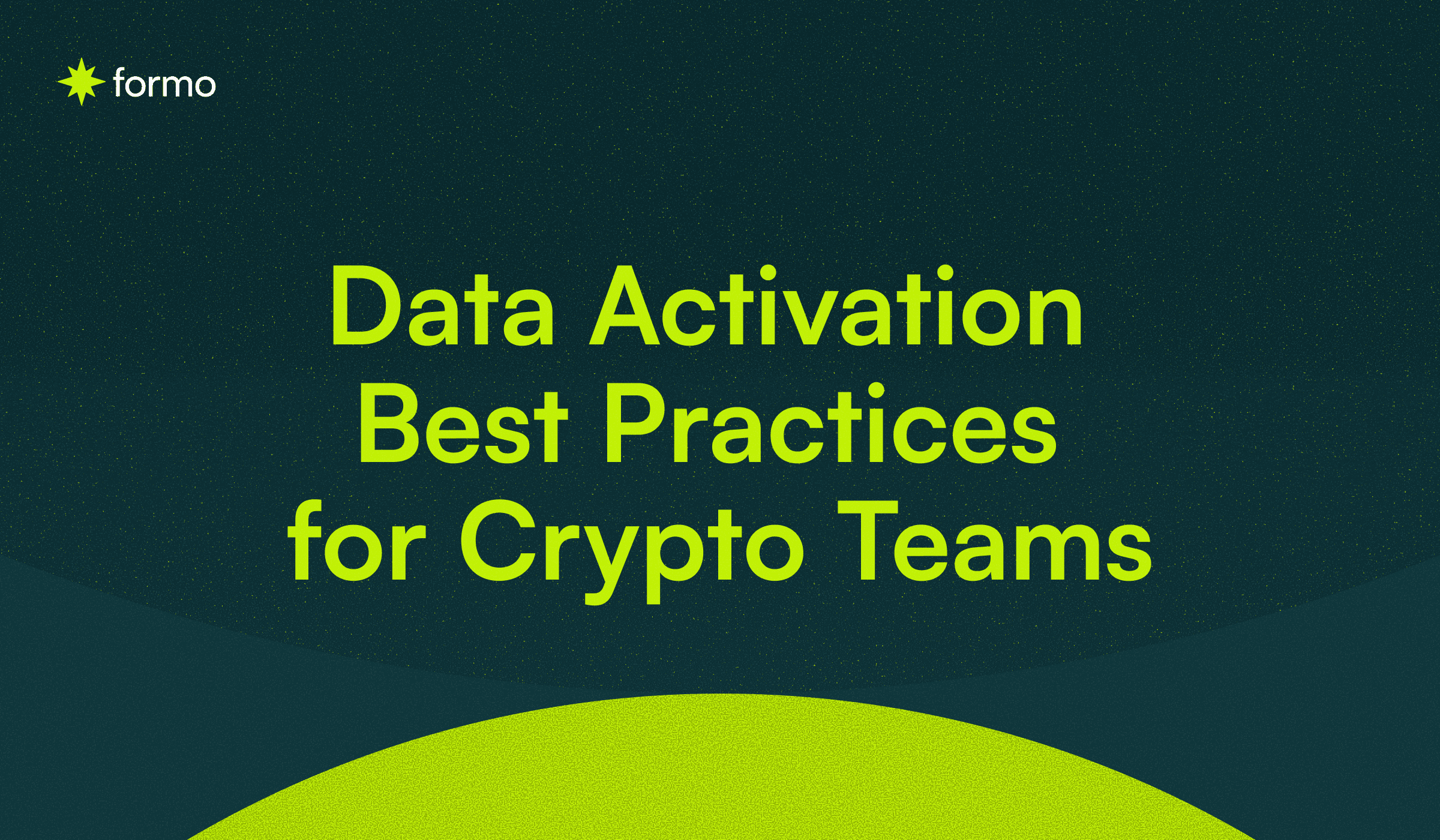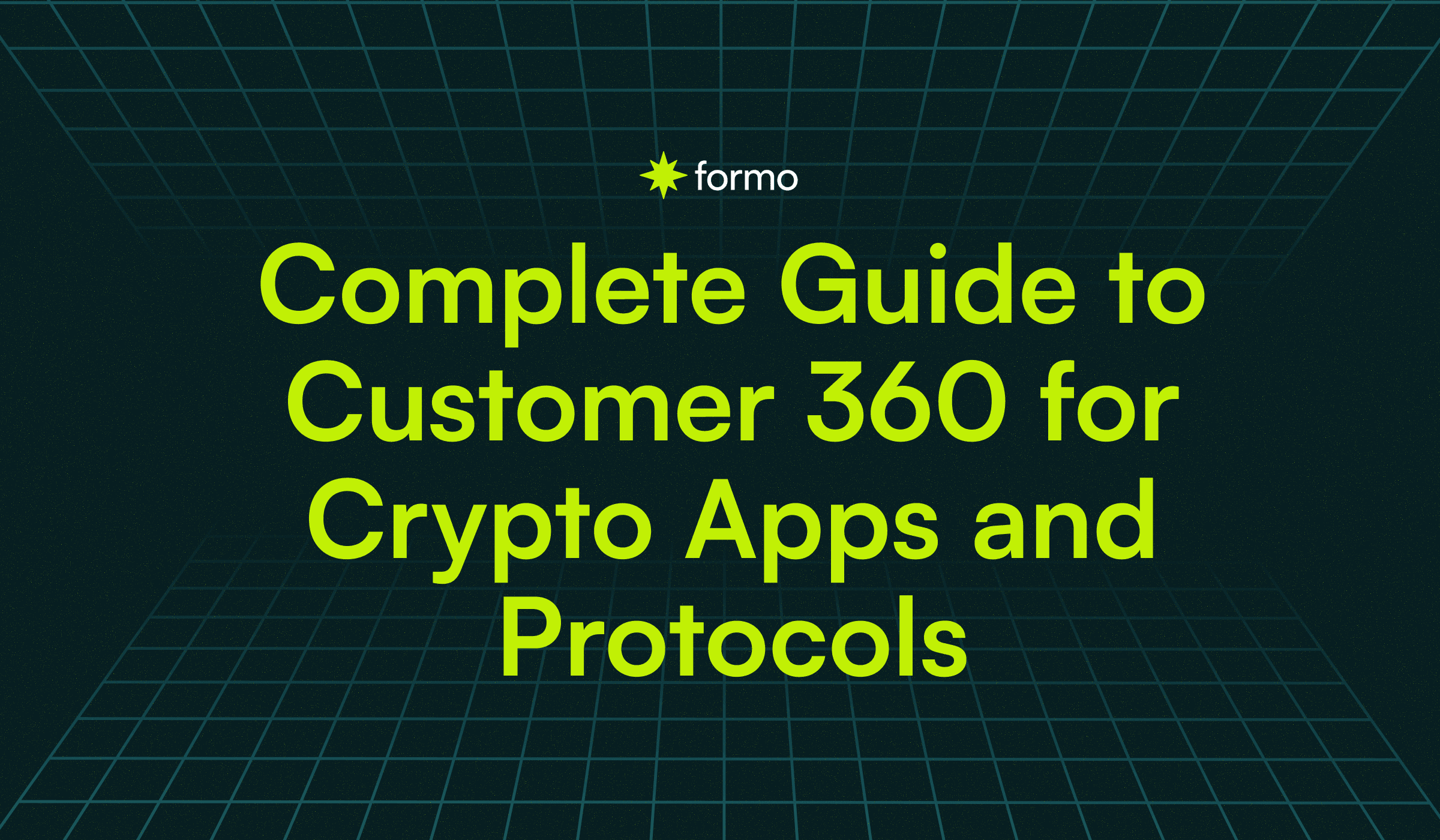As Web3 continues to evolve, marketers face the challenge of reaching, acquiring, and engaging high-value users. Understanding how to effectively segment, target, and engage Web3 audiences is key for product and marketing teams to unlock growth opportunities. In this article, we'll explore Web3 audiences, primary segments within the Web3 ecosystem, user acquisition, and strategies to attract and convert top Web3 users.
Web3 audiences are pseudonymous wallet addresses.
Segment users into collectors, builders, and DAO members to better engage your active users.
Tailor messages based on wallet activity and community engagement.
Wallet messaging and behavior flows boost conversions.
Web3 CRMs like Formo help segment and activate top users.

What Are Web3 Audiences?
In marketing, an audience refers to the group of people you aim to reach with your product or campaign. Web3 audiences are typically pseudonymous users interacting with decentralized applications (dApps), wallets, tokens, NFTs, and blockchain protocols.
Web3 audiences are:
Pseudonymous: Identified by wallet addresses, ENS names, or NFT profile pictures.
User-controlled: Users control their own data and digital assets.
Behavior-driven: Engagement is traceable on-chain.
Community members: Active in DAOs, Discord, Telegram groups, and Web3-native platforms like Farcaster or Lens.
Audience segmentation is a strategy that helps marketers divide large audiences into targeted subgroups based on shared characteristics, leading to more personalized messaging and deeper engagement.
Understanding Web3 Audience Segments
Knowing your audience helps you to tailor campaigns and avoid wasting resources on low-intent users. Here are the most common Web3 audience segments:
1. Crypto Enthusiasts

These users are passionate about cryptocurrencies and blockchain technology. They often lead the charge in adopting new crypto projects, token launches, and decentralized exchanges. Their engagement includes:
Behaviors: Actively trade and hold cryptocurrencies (Bitcoin, Ethereum, etc.). Frequently participate in TGE events, token sales, and trading-related forums.
Channels: Crypto exchanges (e.g., Binance, Coinbase), crypto forums, Telegram groups, Twitter (following crypto influencers), Reddit (r/cryptocurrency), Kaito, Nansen.
Signals: Regularly check crypto market trends, hold multiple crypto assets, engage in discussions about new tokens, and follow news from major crypto publications.
2. NFT Collectors and Creators
Collectors and Creators are engaged with the NFT ecosystem, buying, selling, and minting non-fungible digital collectibles.
Behaviors: Regularly buy, sell, and mint NFTs on platforms like OpenSea, Rarible, or Foundation. Engage with NFT projects via social media and online communities.
Channels: NFT marketplaces (e.g., OpenSea, MagicEden, Rarible), Discord servers, Twitter (NFT-related hashtags like #NFTcommunity, #NFTart), Instagram (for showcasing digital art).
Signals: Have a portfolio of NFTs, actively participate in NFT drops or auctions, follow NFT creators and marketplaces, and engage with project communities (e.g., through Twitter Spaces or Discord chats).
3. DeFi Degens

DeFi users are drawn to peer-to-peer financial services like decentralized exchanges (DEXs), lending protocols, and liquidity farming.
Behaviors: Participate in decentralized finance activities such as yield farming, staking, and liquidity mining. Use decentralized exchanges (DEXs) and lending protocols.
Channels: DeFi protocols (e.g., Uniswap, Aave, Compound), Telegram channels, DeFi Twitter accounts.
Signals: Frequent interaction with DeFi platforms, use decentralized wallets (MetaMask, Trust Wallet), track or analyze yield farming opportunities, and discuss DeFi projects in online communities.
4. DAO Members

DAOs are decentralized organizations where users can vote and contribute to decision-making.
Behaviors: Actively participate in the governance of decentralized autonomous organizations (DAOs) by voting on proposals, submitting ideas, and contributing to community decisions.
Channels: DAO governance platforms (e.g., Snapshot, Tally.xyz), community forums, X community calls, Discord channels.
Signals: Holds personal or delegated governance tokens that allow holders to vote on decisions, participate in DAO forums and community calls, and frequently engage in discussions on governance topics or project funding
5. Web3 Builders and Developers

Builders are the architects of the Web3 ecosystem. They create and maintain decentralized apps (dApps), protocols, and smart contracts. This segment includes:
Behaviors: Build decentralized applications (dApps), smart contracts, and blockchain protocols. Participate in hackathons and open-source development.
Channels: GitHub, Stack Overflow, Web3-specific forums, Twitter (follow Web3 developers), specialized developer platforms (e.g., ConsenSys, Ethereum Foundation).
Signals: Active contributors to open-source blockchain projects, work on smart contracts, participate in audits or hackathons, and engage with projects and discussions on GitHub.
The Importance of Web3 Audience Segmentation

Segmentation enhances your marketing by allowing you to:
Define target audiences.
Tailor messages that resonate.
Solve unique needs to improve conversion.
Build lasting user relationships.
Accelerate lead generation and growth.
Web3 users are a diverse mix of builders, traders, and early adopters. By segmenting your users based on onchain and offchain signals, you can:
Launch personalized campaigns.
Understand users with clarity.
Differentiate in a crowded market.
Improve engagement and retention.
Web3 analytics platforms like Formo help you accelerate growth by tracking wallet behavior, DApp usage, and onchain activity through data-driven segments.
How to Effectively Segment Your Web3 Audience
1. Identify Your Target Audience
The first step is to define who your target audience is. Analyze onchain activity (wallets, tokens, dApps), their social connection (Twitter, Farcaster, Discord), and user interests (DeFi, NFTs, gaming). Understanding their pain points, such as security, UX, and data ownership, helps you craft messages that truly resonate.
2. Segment Your Audience with Data
Once you know who your audience is, segment them into specific groups using data from onchain activity, in-app behavior, and social media interactions. Segment users by transactions, token holdings, or social engagement to deliver personalized, targeted campaigns.
3. Wallet Messaging
Leverage wallet messaging to reach your target Web3 audiences. Align your messaging with the pain points and interests of each segment, ensuring your message reaches the right audience at the right time.
4. Personalize the User Experience
Personalize the user experience with dynamic content based on wallet activity or location. Show tailored content to DeFi users vs. Web3 newcomers, and use behavior email flows to boost engagement and conversions.
5. Measure, Optimize, Repeat
Continuously measure performance. Track engagement, conversions, and retention by segment, and refine your strategies accordingly. Tools like Formo Analytics help you optimize your segmentation and drive better results.
Summary
To recap:
Understand who your top users are with wallet profiles
Segment by behavior, both offchain and onchain
Use Web3 CRMs to engage, convert, and retain
Incentivize long-term usage, not just short-term hype
Web3 audience segmentation is critical for projects and teams aiming to grow and build lasting relationships with their user base. Platforms like Formo enable user segmentation and wallet analysis, providing instant access to live ownership data and evolving customer lists. With Formo, you can effortlessly segment, track, and analyze your Web3 audience, crafting personalized customer journeys based on what resonates with your users' needs.
Further sources:
Follow us on LinkedIn and Twitter, and join our community to see how Web3 leaders use Formo to drive growth in less time.
FAQs
What is Web3 audience segmentation?
Web3 audience segmentation is the practice of dividing users into groups based on shared traits. This involves combining on-chain signals like wallet age and app interactions with off-chain data like traffic sources. Creating these crypto user segments helps you understand user behavior and tailor your marketing.
What on-chain signals can be used for user segmentation?
You can create powerful segments by analyzing wallet behavior. Key signals include wallet tenure, first interaction type, and transaction frequency. Other useful features are portfolio diversity, chain preferences, and interactions with specific smart contracts.
How can off-chain data improve Web3 audience segmentation?
Enrich on-chain data with off-chain signals for a full audience view. Use UTM parameters, referral codes, and email engagement to see which channels attract valuable users. This hybrid approach helps you build more effective segments by mapping the entire user journey.
What are the main use cases for Web3 audience segmentation?
Segmentation lets you create relevant user experiences. You can design custom onboarding for new users versus experienced traders. It also enables targeted campaigns, like offering an exclusive NFT to users holding a specific token or re-engaging inactive wallets.
How can you segment users by lifecycle stage?
Segment users by lifecycle stage with cohort analysis based on their on-chain actions. Group users by the date of their first transaction to track them as they move from new to retained or churned. This shows how well you are keeping users engaged over time.
What tools are needed for Web3 audience segmentation?
A Web3 data pipeline uses several tools. You start with blockchain indexers for raw on-chain data, stored in a data warehouse. Customer data platforms and analytics tools help you analyze behavior, while attribution tools connect on-chain actions to marketing.
What are the privacy considerations for Web3 audience segmentation?
When creating user segments, it's important to consider privacy. Combining public on-chain data with personal information can trigger regulations. Best practices include getting user consent where needed, minimizing data collection, and avoiding unnecessary links to real-world identities.
How should we measure the performance of different user segments?
Measure performance with a north-star metric and KPIs for each segment. For example, track "weekly active wallets" and the rate of first smart contract interactions. This shows which groups are most valuable and helps you focus on high-impact segments.




